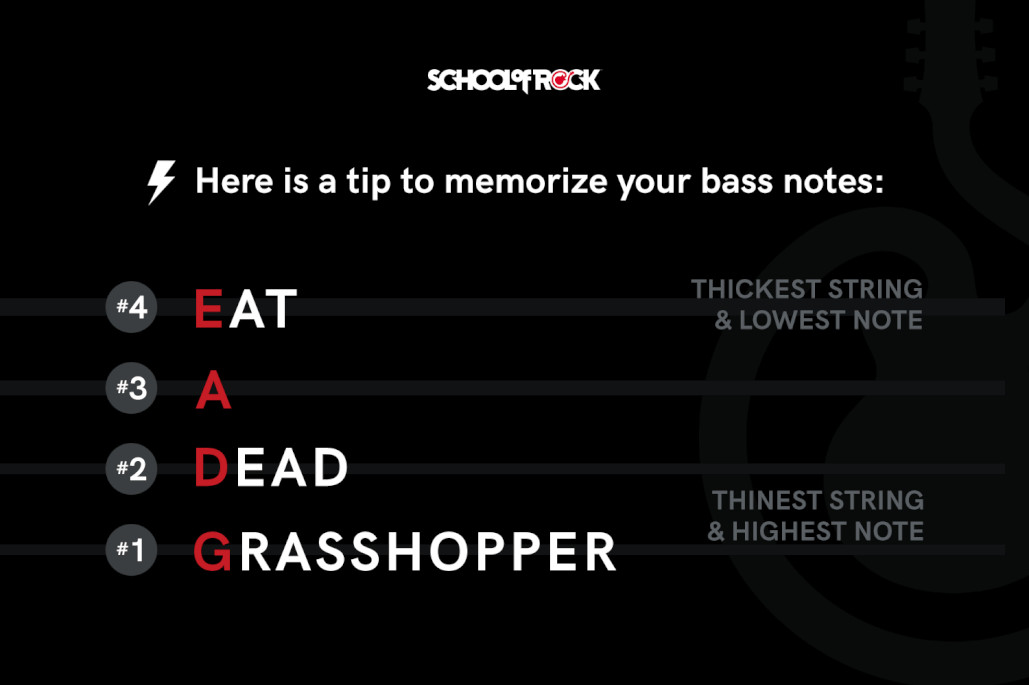Learning bass guitar can be an incredibly rewarding musical journey, and one of the very first steps is understanding the Bass Guitar String Names and how to tune them. A bass guitar that’s out of tune will never sound quite right, no matter how skilled you become. Proper tuning is essential for enjoyable practice sessions, especially when you’re jamming with others or playing along to your favorite songs. Fortunately, tuning your bass guitar is now easier than ever thanks to modern technology and straightforward techniques.
Understanding the Basics of Bass Guitar Tuning
Before we dive into tuning methods, let’s familiarize ourselves with the fundamental components involved. Bass tuning is primarily controlled by the tuning pegs located on the headstock of your bass. These pegs are directly connected to each string. When you turn a tuning peg, you adjust the tension of the string. Tightening the string increases its pitch, making the note sound higher, while loosening the string lowers the pitch, making the note sound lower.
How Often Should You Tune Your Bass Guitar?
A good rule of thumb is to tune your bass guitar every single time you plan to play it. Even if you played recently, basses, like all stringed instruments, can drift out of tune due to changes in temperature, humidity, or simply the settling of the strings. While basses tend to hold their tuning better than standard guitars because of their heavier gauge strings, consistent tuning checks are crucial.
If you notice your bass sounding slightly off while practicing, or if it sounds discordant when playing along with recordings, it’s definitely time to check and adjust your tuning. Accurate tuning will significantly improve your playing experience and ear training.
 Close up of bass guitar headstock with tuning pegs
Close up of bass guitar headstock with tuning pegs
Methods for Tuning Your Bass Guitar
There are primarily two common approaches to tuning a bass guitar, catering to different skill levels and preferences:
- Tuning by Ear: This method involves using a reference note from a reliable source, such as another instrument known to be in tune, a tuning fork, or a pitch pipe. You then listen carefully and adjust your bass strings until they match the pitch of the reference note.
- Using a Tuner: Electronic tuners, especially clip-on tuners, have become incredibly popular and convenient. These devices accurately detect the pitch of your strings and indicate whether they are flat (too low), sharp (too high), or in tune.
Tuning with a Clip-On Electronic Tuner
Clip-on tuners have truly transformed bass guitar tuning, making it more accessible and precise than ever before. Unlike older electronic tuners that required plugging in your instrument, clip-on tuners attach directly to the headstock of your bass. They utilize vibration sensors to detect the pitch of each string, providing real-time feedback on a display. The tuner will clearly show you if your bass guitar notes are too flat (indicated as being below the target note), too sharp (above the target note), or perfectly in tune.
When selecting a clip-on tuner, especially for bass, it’s wise to check if it’s specifically designed to accurately register lower frequencies. Some tuners can struggle to consistently pick up the low E string, which is the lowest note on a standard 4-string bass. Despite this consideration, clip-on tuners are generally affordable, user-friendly, and highly accurate, making them an excellent choice for bassists of all levels. Many bass practice amplifiers also now include built-in tuners, offering another convenient tuning option.
Tuning Your Bass Guitar Without a Dedicated Tuner
Even without a dedicated clip-on or electronic tuner, you have several effective alternatives for tuning your bass guitar:
Utilizing a Tuner App on Your Smartphone or Tablet
The app stores for both Android and iOS devices are filled with numerous tuner applications, many of which are available for free. These apps utilize your device’s built-in microphone to detect the pitch of your bass strings. As you adjust each tuning peg, the app’s display will provide visual feedback, indicating when the string reaches the correct pitch and is in tune. Tuner apps are a readily accessible and surprisingly accurate tuning solution.
Tuning to a Reference Instrument
Another method involves using a reference pitch from another instrument that you know is accurately tuned, such as a piano or keyboard. This technique requires a bit more ear training, as you need to tune one of your bass strings to match the reference pitch purely by ear. Listen to the reference note, then play the corresponding note on your bass. Carefully compare the two pitches and adjust your bass string until it matches the reference note.
Once you have one string accurately tuned using a reference pitch, you can then tune the rest of your bass strings relative to that first tuned string. This is done by playing a fretted note on a lower string and then tuning the open string above it to match that fretted note. We’ll elaborate on this technique further when discussing standard bass tuning.
Bass Guitar Tunings to Know
While there are various alternative tunings, understanding standard tuning and its variations is crucial for any bassist.
Standard Bass Guitar Tuning (4-String Bass)
For a standard 4-string bass guitar, the most common tuning is E, A, D, G. These are the same notes as the four lowest strings on a standard 6-string guitar, but tuned one octave lower, giving the bass its characteristic deep sound. The intervals between these strings are tuned in fourths.
To remember the bass guitar string names in standard tuning, from the thickest string (closest to your head) to the thinnest string (closest to the floor), think of the mnemonic “Eat A Dead Grasshopper”. This corresponds to E, A, D, and G.
 Mnemonic "Eat A Dead Grasshopper" for bass string names
Mnemonic "Eat A Dead Grasshopper" for bass string names
Tuning a 4-string bass to itself (after tuning the E string with a reference):
- E String (1st string): Tune the thickest string to E using a tuner, app, or reference pitch.
- A String (2nd string): Fret the E string at the 5th fret. This note is A. Tune your open A string to match the pitch of the 5th fret of the E string.
- D String (3rd string): Fret the A string at the 5th fret. This note is D. Tune your open D string to match the pitch of the 5th fret of the A string.
- G String (4th string): Fret the D string at the 5th fret. This note is G. Tune your open G string to match the pitch of the 5th fret of the D string.
5-String Bass Guitar Tuning
5-string bass guitars have become increasingly popular, offering an extended lower range or higher range depending on the tuning. The most common 5-string bass tuning adds a low B string below the standard E string: B, E, A, D, G. This expands the bass’s lower register, useful in heavier genres and for players who want a deeper sound. Another less common 5-string tuning adds a high C string above the G string: E, A, D, G, C.
6-String Bass Guitar Tuning
For bassists seeking the widest tonal range, the 6-string bass guitar offers both an extended low and high end. The standard 6-string bass tuning combines both the low B and high C strings: B, E, A, D, G, C.
Drop D Tuning for Bass Guitars
Beyond adding strings, another way to alter your bass’s sound is through drop tunings. Drop tunings became particularly popular in the 1990s, especially in heavier music genres. Drop tuning involves lowering the pitch of your lowest string, typically by a whole step (two frets).
Understanding Drop D Tuning
Drop D tuning specifically refers to lowering the E string down a whole step to D. In standard tuning, the open E string is a fourth below the open A string. By dropping the E string to D, the open D string becomes a fifth below the A string. This creates a heavier, more resonant low end and simplifies playing power chords.
Drop D Tuning Configuration
In Drop D tuning, the bass guitar string names become: D, A, D, G.
Many metal bands and genres that require a heavier sound often utilize even lower drop tunings, such as Drop C (C, G, C, F) or even Drop B (B, F#, B, E). These tunings further lower the bass’s range and contribute to a very deep, powerful tone.
Drop D Tuners
For musicians who frequently switch between standard and drop tunings, drop D tuners are a valuable accessory. These devices attach to the tuning peg of the E string and allow you to quickly and accurately drop the E string down to D and back to E with a simple lever or mechanism, without needing to use a tuner each time.
Maintaining Your Bass Guitar String Names in Tune
Once your bass is properly tuned, there are several preventative steps you can take to help it stay in tune for longer periods:
- Regular String Changes: Bass strings, over time and with use, can lose their elasticity and become less stable in tuning. When your strings start to sound dull, lack sustain, or frequently go out of tune, it’s time to replace them. When installing new strings, remember to stretch them properly. This can be done by gently pulling on the strings or by simply playing the bass, allowing the strings to settle in. Bass strings generally last longer than guitar strings due to their heavier gauge, but regular changes are still important for optimal tone and tuning stability. Depending on playing frequency and desired tone, string changes can range from monthly to every few months.
- Cleanliness is Key: Dirt, oils, and grime from your hands can accumulate on your bass strings, contributing to corrosion and affecting their tone and tuning stability. Always wash your hands before playing your bass. After each playing session, wipe down your strings with a clean, dry cloth to remove any residue.
- Proper Storage and Protection: When you’re not playing your bass, store it in its case or gig bag. This protects it from dust, humidity fluctuations, and temperature changes, all of which can impact tuning stability. Avoid exposing your bass to extreme temperature swings or very humid environments.
By understanding bass guitar string names, mastering tuning techniques, and following these maintenance tips, you’ll ensure your bass is always ready to play and sounds its best, making your musical journey far more enjoyable and productive.
Ready to Take Your Bass Playing Further?
Now that you have a solid understanding of tuning your bass guitar and the bass guitar string names, you’re well-prepared to advance your skills and explore the world of bass playing. School of Rock offers comprehensive bass lessons designed for all skill levels, from beginners just starting out to experienced players seeking to refine their technique. Unlock your potential and become the bassist you’ve always wanted to be – discover School of Rock bass lessons today!
Is your electric guitar also needing a tune-up? Check out our Beginner’s Guide to Tuning a Guitar

